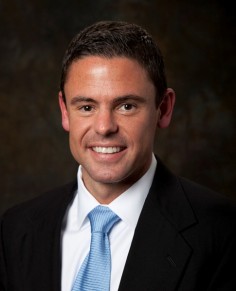The shoulder is one of the most common areas in the body for people to hurt. Most of the time, this pain represents a simple strain or sprain that will heal quickly with minimal treatment. There are, however, times when shoulder pain can mean that there is a significant structural issue that should not be ignored. Rotator cuff injuries can occur from sporting activities such as swimming, softball, baseball, tennis, golf, and weight training, or can simply develop over time due to rotator cuff degeneration. At Raleigh Orthopaedic Clinic, our shoulder specialists are experts at evaluating and treating shoulder pain. This article will discuss one of the most common and feared problems of the shoulder, “the rotator cuff tear”.

What is the rotator cuff?
The rotator cuff is a group of four muscles and their tendons in the shoulder. These muscles come together as tendons to form a “cuff” over the head of the upper arm bone (humerus). These four muscles are the supraspinatus, subscapularis, infraspinatus, and teres minor. These four muscles in conjunction with their tendons are critical to normal shoulder function. The rotator cuff helps to elevate and rotator the arm and is also very important in stabilizing the ball of the shoulder joint (humeral head) in the shallow socket of the shoulder (glenoid). When the arm is overhead, the rotator cuff is critical to stabilize the shoulder and provide power. This is why one of the first symptoms of rotator cuff damage is pain with overhead activity.
What kind of rotator cuff injuries are there?
The most common rotator cuff injury is usually an inflammation of the tendon called tendonitis. There are two common ways for this to happen. In a situation called “impingement syndrome” the rotator cuff can get pinched between the bones of the shoulder and get inflamed. There is a bursa that lies between the rotator cuff and the bone of the scapula (acromion) that can get inflamed as well because of the friction between the tendons of the rotator cuff and the bone. This condition is called bursitis. The second common way for rotator cuff tendonitis to occur is simply through overuse of the tendon. This is common in activities such as weight training and throwing sports.
Sometimes rotator cuff tendonitis can progress to the point where the tendon can start to fray resulting in a rotator cuff tear. Rotator cuff tears can also occur as the result of trauma such as a jerking motion or with lifting a heavy object. Traumatic rotator cuff tears can also occur due to an accident or fall. It is important to note that rotator cuff tears can occur at any age and can happen lots of different ways.
How do I know I have a rotator cuff tear?
The most common symptom seen with a rotator cuff tear is shoulder pain. Typically, patients with rotator cuff tears will note pain that starts in the front or side of the shoulder and can radiate down the arm. The pain is normally increased with overhead activities and with large tears patients may notice weakness in the shoulder. Night pain is a common problem with a rotator cuff tear, and often patients are unable to sleep on the affected side. If you have any of these symptoms, you should be evaluated by a shoulder specialist.
What will happen when I see a shoulder specialist?
If you have injured your shoulder or have chronic shoulder pain you should see a doctor, ideally an orthopaedic surgeon who is a shoulder specialist. Your doctor will start with a history and physical examination. X-rays are commonly obtained to evaluate for fractures or arthritis. If your doctor is concerned about a rotator cuff tear, additional imaging may be ordered such as a magnetic resonance imaging (MRI) scan or an ultrasound. Early diagnosis and treatment of rotator cuff tears is critical to prevent symptoms such as loss of strength and loss of motion from occurring.
What are treatment options for a rotator cuff tear?
Most rotator cuff tears can be treated without surgery. Usually your doctor will write you a prescription for physical therapy to work on strengthening the rotator cuff muscles and other muscles of the shoulder girdle. If the patient has significant pain, anti-inflammatory medications and sometimes steroid injections can be used to help with this and allow physical therapy to be tolerated better.
For patients with high-grade tears where greater than 50% of the thickness of the rotator cuff tendon is torn on the MRI or ultrasound, surgery may be recommended. The goal of the surgery is to restore normal anatomy and allow the patient to regain full strength and motion. Surgery is often done arthroscopically, avoiding any large incisions and is commonly done at an outpatient facility such as Raleigh Orthopaedic Surgery Center. The goal of the surgery is to stitch the tendon back to bone so that the rotator cuff tendon can heal back to its normal anatomic location.
What can I expect after surgery for a rotator cuff repair?
Most patients go home the same day as the surgery and are in a sling for several weeks. Duration of sling uses varies based on multiple factors that include size of the tear and quality of the tendon. Additional factors such as smoking, diabetes, medical conditions, and age may impact your surgeon’s decision on when to discontinue sling use. Physical therapy is a critical component to the healing of the rotator cuff, and your surgeon will work closely with your physical therapist to determine when it is safe to progress activities after surgery. Most patients once they complete physical therapy and are fully healed can return back to all activities. For more information on rotator cuff tears or to schedule an appointment, give us a call today.

This articles was written by Joseph Barker, M.D. Dr. Barker is a fellowship trained orthopaedic surgeon in Sports Medicine and is a team physician for the Carolina Hurricanes, NC State University, and Broughton High School. His areas of expertise include sports medicine, shoulder, hip and knee arthroscopy, and cartilage restoration. Read more about Dr. Joseph Barker.